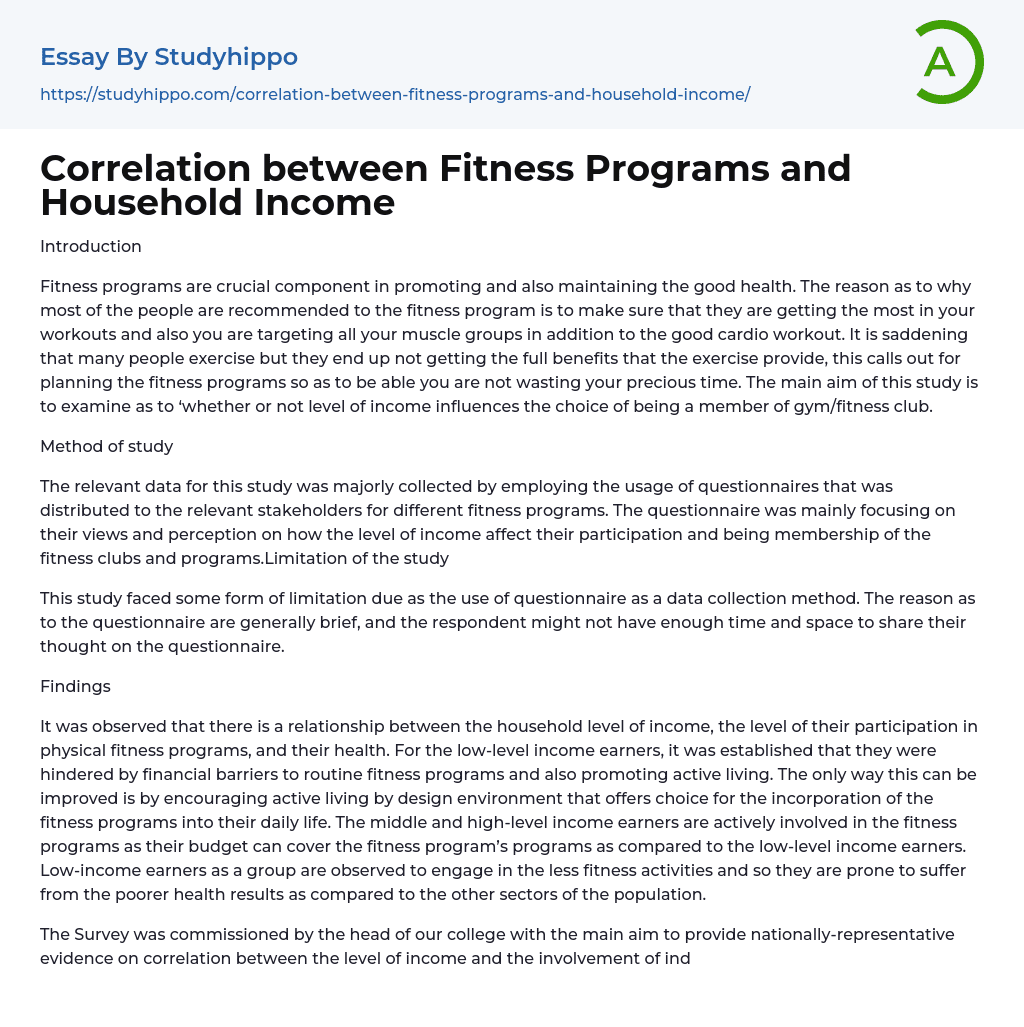

Correlation between Fitness Programs and Household Income Essay Example
Introduction
Fitness programs play a crucial role in promoting and maintaining good health by maximizing workout benefits, targeting all muscle groups, and achieving effective cardio workouts. Unfortunately, many people fail to understand the advantages of exercise. Therefore, it is important to carefully plan fitness programs to avoid wasting time during workouts.
The purpose of this study is to examine how income level affects individuals' decision to join a gym or fitness club.
Methodology
Data for this research was primarily obtained through distributing questionnaires to relevant stakeholders in various fitness programs. These surveys aimed to gather participants' perspectives on how their income level influenced their choice to participate in fitness clubs and programs.
One limitation of the study is that it relied on questionnaires as a means of data collection, which may have limited respondents' ability to f
...ully express their thoughts due to space constraints.
Results
The study found a relationship between household income, engagement in physical fitness programs, and overall health.
The study found that individuals with low incomes face financial barriers to joining fitness programs and promoting active lifestyles. To address this issue, it is crucial to create an environment that incorporates fitness programs into their daily routines. On the other hand, middle and high-income earners are more involved in fitness programs due to their higher budgets. Compared to other population sectors, low-income earners have less engagement in fitness activities and experience poorer health outcomes. Our institution conducted a survey aiming to provide nationally-representative evidence on the link between income level and participation in fitness programs. It also sought to understand the perspectives of low-income workers regarding healthy eating and
physical activity, as well as their nutritional status. Additionally, the study examined how dietary intake is influenced by factors affecting food choices among low-income populations.
The study, funded by the Research foundation in our institution, was conducted by a group of students with the objective of analyzing approximately 15% of the most severely disadvantaged individuals within the sample population.
Overall, the study consisted of 3,728 individuals from 2,477 households and took place from January 2016 to August 2016. It included adults (aged 19 and older) as well as children (aged 2-18).
Gathering data involved face-to-face interviews and self-completed questionnaires that covered environmental, economic, and social factors.
Low-income individuals face greater health issues related to lack of physical activity. Those from households earning less than $15,000 have a higher risk of being diagnosed with diabetes or asthma, suffering from obesity, and experiencing health risks associated with inactivity compared to individuals from families with incomes above $50,000. Furthermore, individuals from low-income households are three times more likely to lead sedentary lifestyles than those from higher-income families. Only 17.6% of low-income individuals meet recommended levels of physical fitness activities, while 39.5% engage in no leisure time activity at all.
Additionally, individuals from households earning below $15,000 have lower ratings for their health and are less likely to utilize fitness programs or exercise for weight control compared to those from higher-income families. Approximately 25.1% of people from families making less than $15,000 never participate in fitness programs and consequently experience obesity that leads them to be around 30 pounds overweight.
The impact of obesity and overweight on mortality and disability rates is significant, with physical inactivity playing a major role. Those who are obese face
a 50-100% higher risk of premature death compared to individuals at a healthy weight. It is clear that household income level influences participation in fitness programs and membership.
Reference
- Theou, O., Brothers, T.D., Rockwood, M.R., Haardt, D., Mitnitski, A. and Rockwood, K., 2013.
- Exploring the relationship between national economic indicators and relative fitness and frailty in middle-aged and older Europeans.Age and ageing, p.aft010. Van der Niet, A.G., Hartman,E., Smith,J.andVisscher,C.,2014.
- Modeling relationships between physical fitness, executive functioning,and academic achievement in primary school children.Psychologyof sportandexercise,
15(4),pp.319-325. - Waterman,M.R.,Wiecha,J.M,.Manne,J,.Tringale,S.M,.Costa,E.andWiecha,J.L,.2014.
- Utilization of afreefitness center-based exercise referral program among women with chronic disease risk factors.Journalof community health39(6),pp."1179-1185.Heyward,V.H.and Gibson,A,.2014.
- American Football essays
- Athletes essays
- Athletic Shoe essays
- badminton essays
- Baseball essays
- Basketball essays
- Benefits of Exercise essays
- Bodybuilding essays
- Boxing essays
- cricket essays
- Fight club essays
- Football essays
- go kart essays
- Golf essays
- Gym essays
- hockey essays
- Martial Arts essays
- Motorcycle essays
- Olympic Games essays
- Running essays
- scuba diving essays
- Ski essays
- snowboarding essays
- Soccer essays
- Sportsmanship essays
- Super Bowl essays
- Surfing essays
- Swimming essays
- Table tennis essays
- Taekwondo essays
- Tennis essays
- Training essays
- Volleyball essays
- wrestling essays
- Yoga essays
- Algebra essays
- Arithmetic essays
- Correlation essays
- Geometry essays
- Measurement essays
- Price Elasticity Of Demand essays
- Regression Analysis essays
- Statistics essays
- Activity essays
- Believe essays
- Comfort Zone essays
- Dance essays
- Fashion essays
- Fishing essays
- Fitness essays



